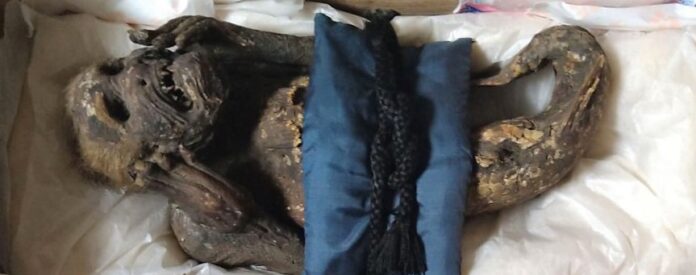A Peculiar Discovery Unveiled
In the heart of Asakuchi City, Japan, a longstanding mystery surrounding the existence of a peculiar creature has finally been unraveled. The enigmatic “mummified mer-monkey” housed at Enju-in Temple, measuring a mere 30 centimeters in length, has baffled and fascinated observers for years. With a furry primate torso fused with a scaly fish tail, adorned with small, pointed teeth and human-like hands, this artifact has now revealed its true nature, shedding light on its origins and captivating the imagination.
Delving into Mythical Lore
Deep-rooted in Japanese mythology, the realm of “ningyo” comes alive—an aquatic world where creatures adorned with fish and human body parts possess a captivating allure. While less renowned than their Western mermaid counterparts, these aquatic beings hold a significant place in lore and tradition. It is within this context that the mummified mer-monkey finds its peculiar existence.
An Investigation Unveiled
Since February 2022, a team of scientists hailing from Kurashiki University of Science and the Arts (KUSA) embarked on a collaborative endeavor with Enju-in Temple to decipher the secrets behind this intriguing oddity. Through meticulous and non-destructive examination techniques, they pieced together the puzzle, revealing a fascinating tale of human craftsmanship and creativity.
Unmasking the Craftsmanship
Scanning beneath the surface of the mer-monkey, the researchers unveiled a web of intricate construction. Contrary to grotesque notions of monkey and fish cadavers stitched together, this artifact was not a ghastly amalgamation. Instead, cloth, cotton, and paper formed the primary materials, while a mixture of charcoal powder or sand and paste coated the exterior. The head, predominantly composed of cotton, was delicately covered with a gypsum-like substance.
A Tapestry of Origins
As the investigation delved deeper, the origin of the mer-monkey’s parts became clearer. Scales, derived from two distinct fish species, embellished its intriguing form. Puffer fish skin graced the upper body, while the lower body featured the scaly skin of a croaker. The creature’s nails, composed of animal keratin resembling horn, adorned its five fingers. Additionally, a carnivorous fish’s jawbone played a role in its construction.
Time Unveils Surprises
Radiocarbon dating further unveiled intriguing insights. The scales, examined through this scientific lens, contradicted the date suggested by a handwritten note found within the artifact’s storage box. The mummified mer-monkey’s creation was estimated to have taken place in the late 1800s, over a century later than initially believed. This revelation added an unexpected twist to the creature’s history.
A Lasting Enigma and Cultural Reflection
While the mysteries surrounding the acquisition of the mer-monkey by Enju-in Temple remain unresolved, the true nature of its construction has been unveiled. This unique artifact, meticulously crafted by skilled artists and craftsmen, holds a significant place in history, representing an era of artistic expression and cultural fascination. With its return to the temple’s embrace, the mer-monkey will continue to be preserved as a testament to the captivating allure of mythical creatures.
Unveiling the Tapestry of Japan’s Mythical Heritage
The discovery and examination of the mer-monkey not only unraveled the enigma surrounding this specific artifact but also contributed to a deeper understanding of the broader landscape of enigmatic creations found throughout Japan. The collaborative efforts between the KUSA scientists and Enju-in Temple have shed light on the rich traditions, artistic expressions, and intricate mythologies that have shaped Japanese culture.
By employing a multidisciplinary approach that combined scientific analysis with historical context, the researchers have peeled back the layers of the mer-monkey’s fabric and structure. This endeavor has not only satisfied the curiosity surrounding this particular artifact but has also provided valuable insights into the cultural, artistic, and mythical tapestry of Japan.
As we venture into the realms of the past, exploring and studying the remnants of history, we gain a deeper appreciation for the diverse landscapes that have shaped our world. The mummified mer-monkey stands as a testament to human creativity and imagination, bridging the realms of reality and fantasy. It serves as a captivating link between ancient mythology and contemporary understanding, leaving us in awe of the artistic prowess and enduring allure of mythical creatures.
The revelation of the mer-monkey’s true nature invites us to reflect on the profound significance of folklore and mythology in shaping cultural identities. It reminds us of the enduring power of storytelling and the human fascination with the extraordinary. The mer-monkey, a unique manifestation of Japan’s mythical heritage, captures the imaginations of generations past and present, and its existence will continue to inspire awe and wonder for generations to come.
In conclusion, the journey to uncover the identity of Japan’s mummified mer-monkey has been a captivating tale of intrigue and discovery. Through a careful examination of its construction and origins, the enigma surrounding this artifact has been demystified, revealing a testament to human craftsmanship and the enduring allure of mythical creatures. As we continue to unravel the secrets of the past, we gain a deeper understanding of the cultural traditions and artistic expressions that have shaped our world. The mer-monkey stands as a remarkable artifact, connecting us to the rich mythologies and folklore of Japan, and leaving us in awe of the human imagination and ingenuity that brought it to life.














